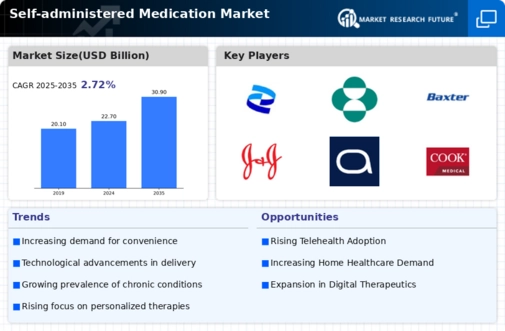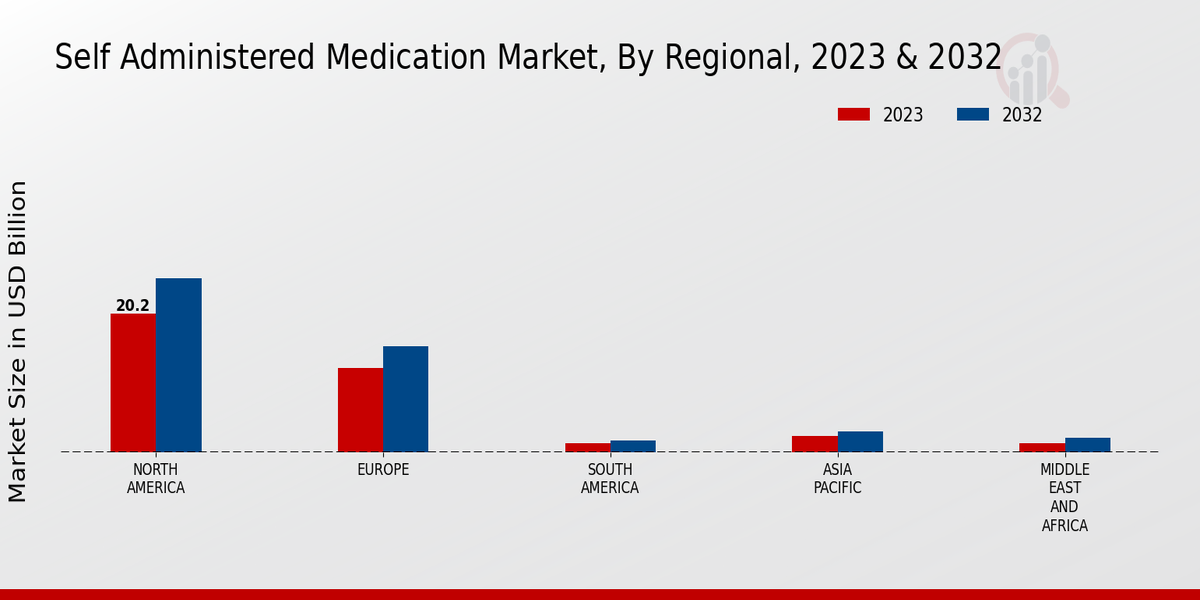Market Growth Projections
The Global Self-administered Medication Market Industry is poised for substantial growth, with projections indicating a market value of 22.7 USD Billion in 2024 and an anticipated increase to 30.9 USD Billion by 2035. This growth trajectory suggests a compound annual growth rate (CAGR) of 2.84% from 2025 to 2035. Such projections reflect the increasing adoption of self-administered therapies, driven by factors such as technological advancements, regulatory support, and changing patient preferences. As the market evolves, it is likely to witness the introduction of innovative self-administration solutions that cater to diverse patient needs, further propelling its growth.
Increased Awareness and Education
Increased awareness and education regarding self-administration of medications play a crucial role in the Global Self-administered Medication Market Industry. Healthcare providers and organizations are actively promoting the benefits of self-administration, which empowers patients to manage their conditions effectively. Educational initiatives aimed at both patients and healthcare professionals are fostering a better understanding of self-administered therapies, leading to higher adoption rates. This growing awareness is likely to contribute to the market's expansion, with projections indicating a rise to 30.9 USD Billion by 2035. As patients become more informed, the demand for self-administered medications is expected to increase, reflecting a shift towards proactive health management.
Rising Prevalence of Chronic Diseases
The increasing prevalence of chronic diseases globally is a key driver of the Global Self-administered Medication Market Industry. Conditions such as diabetes, hypertension, and asthma necessitate ongoing treatment, often leading patients to prefer self-administration for convenience and autonomy. As of 2024, the market is projected to reach 22.7 USD Billion, reflecting the growing demand for medications that can be administered at home. This trend is likely to continue as the World Health Organization reports that chronic diseases account for 71 percent of all deaths globally, underscoring the need for effective self-management solutions.
Growing Preference for Home Healthcare
The shift towards home healthcare is a notable driver of the Global Self-administered Medication Market Industry. Patients increasingly prefer to manage their health from the comfort of their homes, driven by factors such as convenience, cost-effectiveness, and the desire for independence. This trend is particularly evident among the aging population, who often require ongoing medication management. As the market evolves, it is anticipated to grow at a CAGR of 2.84% from 2025 to 2035, reflecting the sustained interest in self-administered therapies that facilitate home-based care. This preference aligns with broader healthcare trends emphasizing patient-centered approaches.
Regulatory Support for Self-Administration
Regulatory frameworks increasingly support self-administration of medications, thereby bolstering the Global Self-administered Medication Market Industry. Governments and health authorities are recognizing the importance of empowering patients to take control of their health, leading to the approval of various self-administered therapies. This regulatory support not only enhances patient access to essential medications but also encourages pharmaceutical companies to innovate in this space. As a result, the market is expected to expand significantly, with a projected value of 22.7 USD Billion in 2024. Such supportive policies may facilitate the introduction of new self-administered products, further driving market growth.
Technological Advancements in Drug Delivery Systems
Technological innovations in drug delivery systems significantly influence the Global Self-administered Medication Market Industry. Developments such as smart inhalers, wearable devices, and mobile health applications enhance patient engagement and adherence to treatment regimens. These advancements not only improve the efficacy of self-administered medications but also empower patients to monitor their health more effectively. The integration of technology is expected to contribute to the market's growth, with projections indicating a rise to 30.9 USD Billion by 2035. This evolution in drug delivery systems may lead to a more personalized approach to medication, aligning with the increasing demand for tailored healthcare solutions.



















